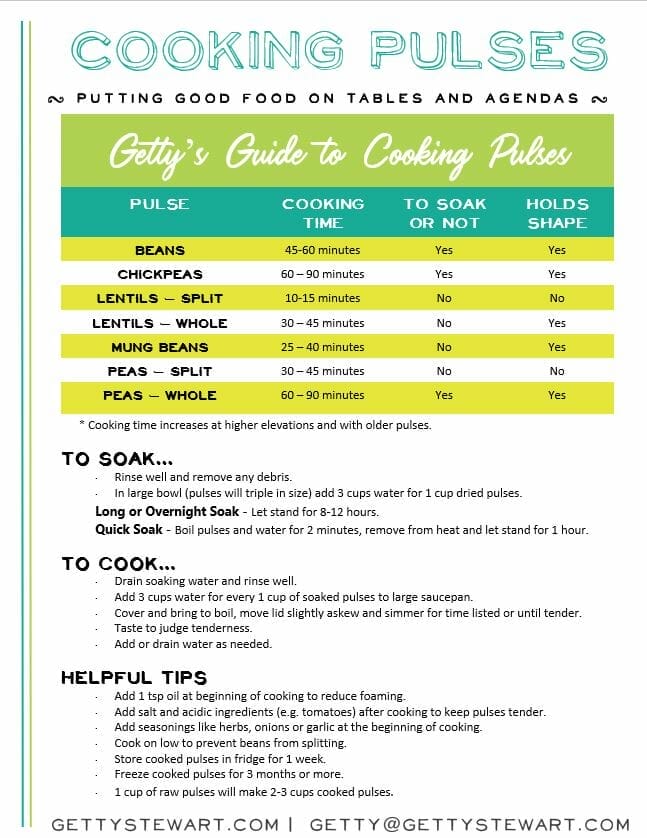How to Cook Pulses – Beans, Peas & Lentils
All the info you need on how to cook pulses – you know dried beans, split peas, chickpeas and lentils. If you need a refresher on pulses, legumes, why they’re healthy and why you don’t need to worry about lectins or toxins scroll to the bottom half of this article. If you’re ready to get cooking – let’s jump right in.
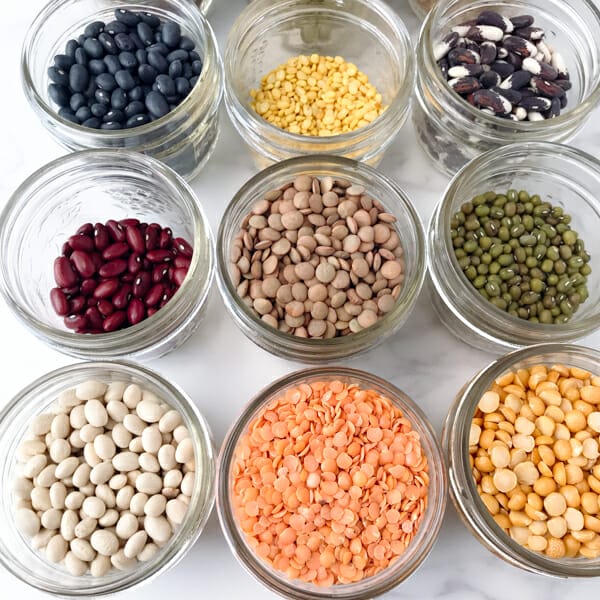
Also Read: 10 Ways to Add Pulse to Your Cooking, How to Cook Chickpeas On Stove or Instant Pot, Dried Pulses in DIY Soup Mixes
How to Cook Pulses in a Regular Pot
Dried beans, peas, chickpeas and lentils are dry and rock hard. For most varieties, you need to soak them for 8 hours and then cook them for 30-60 minutes. The details are on this handy dandy chart for how to cook pulses. Go ahead, click it and print it for easy reference! It shows you which types of beans need to be soaked or not and which type of beans will hold their shape or go to mush (which is sometimes a good thing). Different bean varieties will need different cooking times depending on their size and how old they are.
How to Cook Beans in a Pressure Cooker or Instant Pot
Cooking beans in a pressure cooker will speed up the cooking process for sure. Pre-soaking your beans before pressure cooking is optional. Wait, what?!
Why would anyone soak beans before pressure cooking?
- to get more consistency in bean texture
- to get softer beans with a creamier texture inside
- to get fewer split skins
- to make beans easier to digest (reducing oligosaccharides means less bloating and farting)
- to prep beans for use in recipes like falafel that require soaked not cooked beans
Either soak them for 8 hours in a bowl of water. Or do a quick soak in your pressure cooking as described here.
Using the Pressure Cooker
- Rinse beans – whether soaked or not soaked.
- Add to pressure cooker.
- Add 3 cups water for every 1 cup of beans. DO NOT fill more than half full including water.
- Add 1 Tbsp of oil to prevent foaming.
- Put lid on and seal vent. Select high pressure and set timer according to bean type (see charts below).
- When finished cooking, let pressure release naturally (about 30 minutes). This will result in smoother beans with fewer split skins.
Selecting Timing Based on Type of Beans, Pressure & Bean Use
- Larger beans will take longer than small or split beans. See the chart below from the Instant Pot website.
- The older the beans, the longer they’ll take to cook. If they’ve been in your cupboard for years – add 10 min. It’s hard to tell how old a bean is. Your best bet is to buy beans where turn over is fast, eg. bulk shops vs grocery stores with bagged dried beans no one ever buys.
- Use high pressure to cook your beans. Most cookers go up to 12psi, some go to 15psi. The higher the psi the less cooking time. Find the correct chart below.
- Pre-soaking will reduce cooking time. The charts below show two times D is for dry, unsoaked beans, S is for soaked beans.
- Consider how you will use your beans. If you want ultra-soft beans for soups, purees or hummus you may want to add 5-10 minutes.
- Experiment and keep notes. Every bean and every pot will be slightly different. That’s a good organic thing that happens with food!
- Notice the charts below don’t include red lentils or split mung beans. These pulses cook up super fast without soaking. You’re best off to cook them in a regular pot.
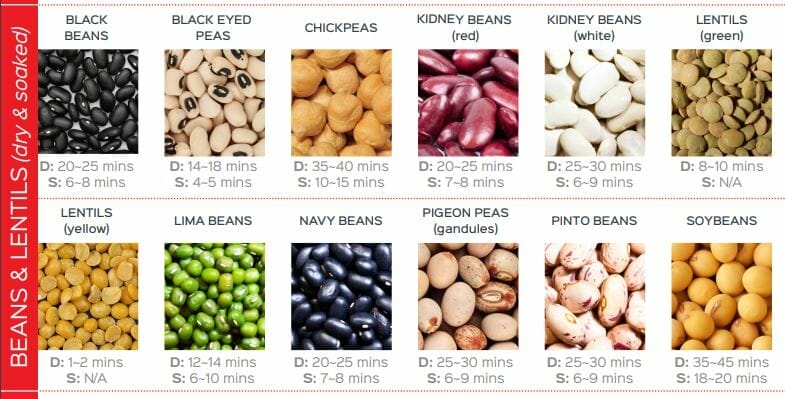
Here are suggested times from InstantPot for 12 psi (most common cookers).
If you have the MAX or other super high pressure cookers that go to 15 psi, use this chart.
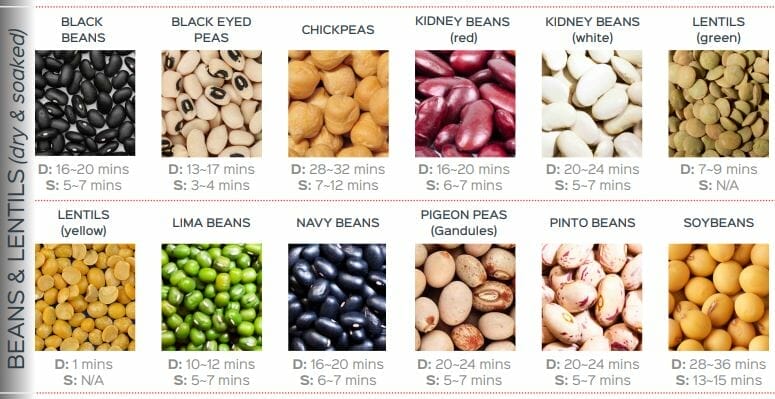
Bean Measurements & Equivalents
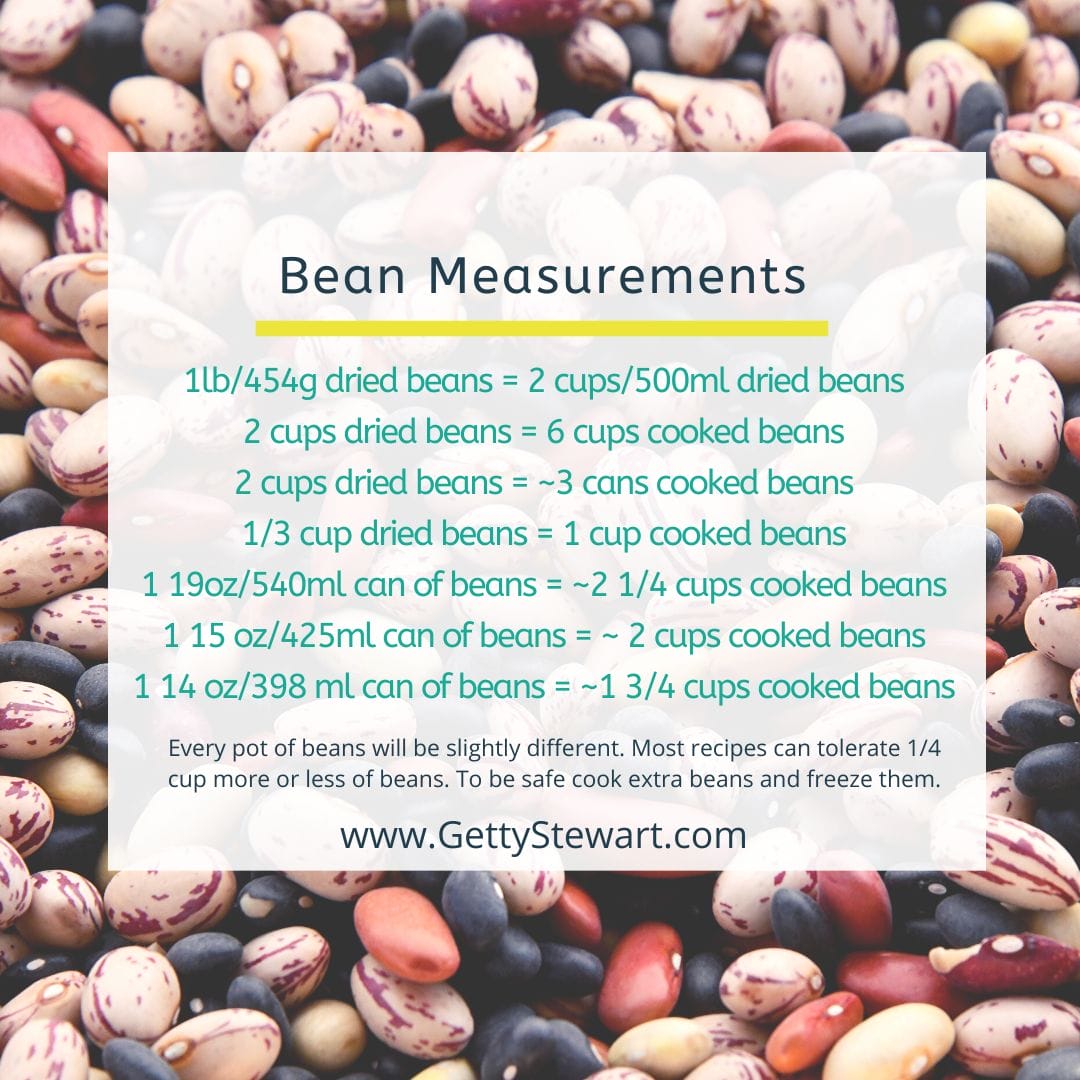
What Exactly are Pulses?
Pulses are the dried edible seeds of plants called legumes. A pulse is the dried seed. A legume is the plant. Not all legumes produce edible pulses. Plants like peanuts, soybeans, fresh garden peas and fresh garden beans are legumes – but their seeds are not pulses. The term pulses refers to the dried edible seeds – beans, chickpeas, dry peas and lentils.
There are hundreds of varieties of pulses. Take beans for example, there are black beans, navy beans, red or white kidney beans (aka Cannellini beans), pinto beans (refried beans), navy beans (baked beans), lima beans, red beans, mung beans (think bean sprouts), garbanzo beans (aka chickpeas). And then there are fancy beans like cranberry beans, appaloosa beans, adzuki beans, black eyed beans, pink beans, lupini, broad beans, orca beans and so on – the list is endless!
Benefits of Pulses
Pulses are one of, if not THE world’s most nutritious and economical food. They are an excellent source of plant-based proteins and part of eating for brain health among the most highly recommended and researched plans for eating healthy – DASH diet, Mediterranean diet, MIND diet and Canada’s Food Guide.
Pulses offer an ideal combination of protein, good long lasting carbohydrates and fat. They also offer and excellent source of fiber, folate, iron, potassium and magnesium. They’ve been shown to support digestion, reduce cholesterol, regulate blood sugar, promote heart health and reduce the risk of cancer. Yeah, they’re good. Everyone who’s anyone in the world agrees, even the United Nations.
Heard concerns about phytotoxins, lectins or oxalates in beans? Unless you’re eating beans raw, I haven’t found evidence to support these are legitimate concerns. Prepare and cook them properly and you’re good to go. Don’t eat raw beans and read this article and its sources in HuffPost.
Whether you cook beans from their dried state or used canned beans – they’re all good. Canned beans are a fantastic convenience item! Just rinse them well to remove up to 40% of the sodium.
My Favorite Pulse Recipes
Here’s a list of recipes using pulses that you’ll find on this site. And remember, using canned beans is totally OKAY!
Southwestern Black Bean, Sweet Pepper and Corn Salsa/Salad
Mediterranean Veggie & Chickpea Pasta Salad
Wheatberry Salad with Chickpeas
Zesty Black Bean and Quinoa Salad
Vegan Cauliflower Chickpea Curry
Beet & Bean Soup – Vegetarian Borscht
Lentil Soup with or without Bacon
Butternut Squash and Three Bean Chili – Vegetarian
Beef ‘n Bean Chili – Classic Chili Con Carne
Black Bean and Corn Stuffed Avocados
Vegetable Quinoa and Red Lentil Soup Mix
I’d love to hear about your experience beans, peas and lentils and which ones you love and use the most. Share your recipes, leave a comment or tag me on your Instagram photos @getgettys so I can see and like your creations.
Sign up to get articles by Getty delivered to your inbox. You’ll get recipes, practical tips and great food information like this. Getty is a Professional Home Economist, speaker and writer putting good food on tables and agendas. She is the author of Manitoba’s best-selling Prairie Fruit Cookbook, Founder of Fruit Share, a mom and veggie gardener.


